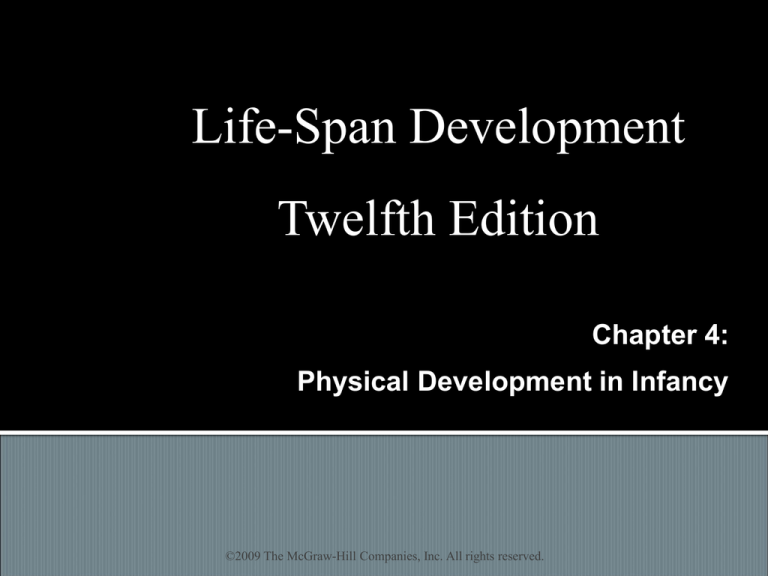
Life-Span Development
Twelfth Edition
Chapter 4:
Physical Development in Infancy
©2009 The McGraw-Hill Companies, Inc. All rights reserved.
Patterns of Growth:
Cephalocaudal Pattern: sequence in which the
earliest growth always occurs from the top
downward
▪ Also applies to gains in motor development
Proximodistal Pattern: sequence in which growth
starts in the center of the body and moves toward
the extremities
©2009 The McGraw-Hill Companies, Inc. All rights reserved.
Height and Weight:
Average North American newborn is 20 inches
long and 7 ½ pounds
▪ 95% of full-term newborns are 18-22 inches long and
weigh between 5 ½ and 10 lbs.
▪ Newborns lose 5-7% of their body weight in the first few
days of life
▪ They typically gain 5-6 ounces per week during the first month
Weight usually triples by their 1st birthday
▪ Newborns gain approximately 1 inch per month during
the first year
Growth slows considerably during the 2nd year
©2009 The McGraw-Hill Companies, Inc. All rights reserved.
©2009 The McGraw-Hill Companies, Inc. All rights reserved.
The Brain:
Brain continues developing past infancy
Shaken Baby Syndrome: brain swelling and
hemorrhaging from child abuse trauma
Brain imaging technologies cannot typically be used
with babies
▪ EEGs show regular spurts in the brain’s electrical activity
▪ Spurts may coincide with important changes in cognitive
development
At birth, the brain is 25% of its adult weight; at 2
years of age, it is 75% of its adult weight
▪ The brain does not mature uniformly
©2009 The McGraw-Hill Companies, Inc. All rights reserved.
Forebrain: portion of the brain farthest from the
spinal cord; includes cerebral cortex
Cerebral Cortex: folded surface covering the
forebrain
Cerebral cortex is divided into 2 hemispheres, each
with 4 lobes
▪ Frontal lobe: voluntary movement, thinking, personality, and
intentionality
▪ Occipital lobe: vision functions
▪ Temporal lobe: hearing, language processing, and memory
▪ Parietal lobe: spatial location, attention, and motor control
©2009 The McGraw-Hill Companies, Inc. All rights reserved.
Lateralization: specialization of function in
one hemisphere of the cerebral cortex or the
other
Some functions are lateralized, some are not
▪ Complex functions involve communication between
both hemispheres
©2009 The McGraw-Hill Companies, Inc. All rights reserved.
©2009 The McGraw-Hill Companies, Inc. All rights reserved.
Neurons: brain nerve cells that communicate
through electrical and chemical signals
Axons carry signals away from the cell body
Dendrites carry signals toward the cell body
Myelin sheath is a layer of fat cells that insulate
axons
▪ Helps electrical signals travel faster
Terminal buttons release chemicals
(neurotransmitters) into synapses
▪ Synapses: tiny gaps between neurons
©2009 The McGraw-Hill Companies, Inc. All rights reserved.
©2009 The McGraw-Hill Companies, Inc. All rights reserved.
Changes in Neurons:
Myelination: the process of encasing axons with
fat cells
▪ Begins prenatally and continues into adolescence
Connectivity among neurons increases
▪ New dendrites grow
▪ Connections among dendrites increase
▪ Synaptic connections increase
More synaptic connections are created than will
ever be used
▪ Leads to a “pruning” of unused connections
©2009 The McGraw-Hill Companies, Inc. All rights reserved.
©2009 The McGraw-Hill Companies, Inc. All rights reserved.
Changes in
regions of the
brain:
“Blooming and
pruning” of
synapses varies by
brain region
Pace of myelination
varies as well
©2009 The McGraw-Hill Companies, Inc. All rights reserved.
Depressed brain activity has been found in
children who grow up in a deprived environment
Enriched environments promote faster brain
development than deprived ones
After birth: sights, sounds, smells, touches,
language, and eye contact help shape the
brain’s neural connections
Repeated experience wires (and rewires) the brain
Brain is both flexible and resilient
©2009 The McGraw-Hill Companies, Inc. All rights reserved.
©2009 The McGraw-Hill Companies, Inc. All rights reserved.
Typical newborns sleep 16-17 hours per day
Infants vary in their preferred times for sleeping
Most have moved closer to adult-like sleep patterns
by 4 months of age
Factors involved in night waking:
Daytime crying and fussing
Distress when separated from mother
Breast feeding
Co-sleeping
©2009 The McGraw-Hill Companies, Inc. All rights reserved.
Cultural variations influence infant sleeping
patterns
Babies average much more REM sleep than
do older children or adults
REM sleep may provide infants with added self-
stimulation
REM sleep may also promote brain development
We do not know whether infants dream or not
©2009 The McGraw-Hill Companies, Inc. All rights reserved.
©2009 The McGraw-Hill Companies, Inc. All rights reserved.
The practice of shared sleeping, in which a newborn
shares a bed with mother, varies among cultures
Potential benefits:
Promotes breast feeding and a quicker response to
crying
Allows mother to detect potentially dangerous breathing
pauses in baby
American Academy of Pediatrics discourages shared
sleeping
Increases risk of injury (rolling over baby) and SIDS
©2009 The McGraw-Hill Companies, Inc. All rights reserved.
SIDS (Sudden Infant Death Syndrome):
infants stop breathing and die without
apparent cause
Highest cause of infant death in U.S. annually
Highest risk is 2-4 months of age
Risk decreases when infant sleeps on its back
and when a pacifier is used
©2009 The McGraw-Hill Companies, Inc. All rights reserved.
Other risk factors associated with SIDS:
Siblings who died from SIDS
Sleep apnea or low birth weight
Infants passively exposed to cigarette smoke
Being from lower SES or being African American
or Eskimo
Infants placed in soft bedding
Infants with abnormal brain stem functioning
involving serotonin
©2009 The McGraw-Hill Companies, Inc. All rights reserved.
Experts recommend that infants consume 50
calories per day for each pound they weigh
U.S. parents typically do not feed infants
enough fruits and vegetables
By 15 months, French fries are the most common
vegetable eaten
Increasing rates of overweight and obese
infants
Other factors:
▪ Mother’s weight gain during pregnancy and pre-pregnancy
weight
▪ Breast feeding vs. bottle feeding
©2009 The McGraw-Hill Companies, Inc. All rights reserved.
©2009 The McGraw-Hill Companies, Inc. All rights reserved.
American Academy of Pediatrics strongly
endorses breast feeding throughout the first
year
Benefits for baby can include:
Fewer gastrointestinal and lower respiratory tract
infections
Potentially decreased risk of asthma
Less likely to become overweight or obese
Less incidence of diabetes
Less likely to experience SIDS
©2009 The McGraw-Hill Companies, Inc. All rights reserved.
Benefits for mother can include:
Lower incidence of breast and ovarian cancer
Lower incidence of Type 2 diabetes
Breast feeding does not:
Help mother return to pre-pregnancy weight
Guard against osteoporosis
Decrease likelihood of experiencing post-partum
depression
©2009 The McGraw-Hill Companies, Inc. All rights reserved.
Women less likely to breast feed:
Mothers who work full-time outside of the home
Mothers under age 25
Mothers without a high school education
African-American mothers
Mothers in low-income circumstances
©2009 The McGraw-Hill Companies, Inc. All rights reserved.
Mother should not breast feed if:
She has AIDS or other infectious diseases that can
be transmitted through milk
She has active tuberculosis
She is taking a drug that may not be safe for the
infant
No psychological differences have been found
between breast-fed and bottle-fed infants
Most breast- vs. bottle-feeding studies are
correlational and do not imply causation
©2009 The McGraw-Hill Companies, Inc. All rights reserved.
Malnutrition in Infancy:
Early weaning and inadequate sources of
nutrients can cause malnutrition
Marasmus: a severe protein-calorie deficiency
▪ Results in a wasting away of body tissues
Kwashiorkor: a severe protein deficiency that
causes the abdomen and feet to swell with water
▪ Causes the vital organs to collect nutrients, depriving
other parts of the body
Severe and lengthy malnutrition is detrimental to
physical, cognitive, and social development
©2009 The McGraw-Hill Companies, Inc. All rights reserved.
Dynamic Systems View:
Infants assemble motor skills for perceiving and
acting
▪ Motor skills represent solutions to goals
Development is an active process in which nature
and nurture work together
▪
▪
▪
▪
Development of nervous system
Body’s physical properties and possibilities for movement
Goal the child is motivated to reach
Environmental support for the skill
©2009 The McGraw-Hill Companies, Inc. All rights reserved.
Reflexes: built-in reactions to stimuli; generally
carry survival mechanisms
Rooting Reflex: when the infant’s cheek is stroked,
the infant will turn its head to the side that was
touched
Moro Reflex: automatic arching of back and
wrapping of arms to center of body
when startled
Grasping Reflex: infant’s hands close around
anything that touches the palms
Some reflexes continue throughout life; others
disappear several months after birth
©2009 The McGraw-Hill Companies, Inc. All rights reserved.
Gross Motor Skills: skills that involve large-muscle
activities
Walking, grabbing for objects
Gross motor skills require postural control
Posture is a dynamic process linked with sensory
information in the skin, joints, and muscles
Infants can produce stepping movements needed for
walking from a very early age
They lack the ability to stabilize balance on one leg at a
time
Infants learn what kinds of places and surfaces are safe
for locomotion
©2009 The McGraw-Hill Companies, Inc. All rights reserved.
©2009 The McGraw-Hill Companies, Inc. All rights reserved.
Development in the 2nd Year:
Toddlers become more skilled and mobile
Motor activity is vital to the child’s development of
competence and independence
By 18-24 months, toddlers can:
▪
▪
▪
▪
▪
Walk quickly or run stiffly
Balance on their feet in a squat position
Walk backward
Stand and kick a ball without falling
Jump in place
©2009 The McGraw-Hill Companies, Inc. All rights reserved.
Cultural Variations: mothers in developing
countries tend to stimulate their infants’
motor skills more than mothers in more
modern countries
Infants can reach motor milestones slightly
earlier if provided with physical guidance or given
opportunities for exercise
Even when activity is restricted, many infants still
reach milestones at a normal age
©2009 The McGraw-Hill Companies, Inc. All rights reserved.
Fine Motor Skills: involve finely tuned movements
Reaching and grasping is a significant milestone for
infants
Palmer grasp: grasping with the whole hand
Pincer grip: grasping with the thumb and forefinger
Perceptual-motor coupling is necessary for infants to
coordinate grasping
Experienced infants look at objects longer, reach for
them more, and are more likely to mouth the objects
©2009 The McGraw-Hill Companies, Inc. All rights reserved.
Sensation: occurs when information interacts
with sensory receptors (eyes, ears, tongue,
nostrils, and skin)
Perception: the interpretation of what is sensed
Ecological View: we directly perceive
information that exists in the world around us
The perceptual system selects from the rich
information provided by the environment
Perception enables interaction with, and adaptation
to, one’s environment
©2009 The McGraw-Hill Companies, Inc. All rights reserved.
Affordances: opportunities for interaction
offered by objects that fit within our
capabilities to perform activities
What affordances can infants or children detect
and use?
▪ Children become more efficient at discovering and
using affordances through perceptual development
©2009 The McGraw-Hill Companies, Inc. All rights reserved.
Visual Preference Method: infants look at
different things for different lengths of time
They look at preferred objects longer
Habituation: decreased responsiveness to a
stimulus after repeated presentations
Dishabituation: recovery of a habituated
response after a change in stimulation
©2009 The McGraw-Hill Companies, Inc. All rights reserved.
©2009 The McGraw-Hill Companies, Inc. All rights reserved.
Habituation and Dishabituation Studies:
High-amplitude sucking
Orienting response
Tracking
Videotaping
Recording heart rate, respiration, body
movement, sucking behavior, visual fixation
©2009 The McGraw-Hill Companies, Inc. All rights reserved.
Newborn’s vision is about 20/600 (an object 20
feet away appears as if it were 600 feet away)
By the age of 6 months, vision is 20/100 or
better
Vision approximates that of an adult by the infant’s
first birthday
Infants show an interest in human faces soon
after birth
The way they gather information about the visual
world changes rapidly with age
©2009 The McGraw-Hill Companies, Inc. All rights reserved.
©2009 The McGraw-Hill Companies, Inc. All rights reserved.
©2009 The McGraw-Hill Companies, Inc. All rights reserved.
Perceptual Constancy: sensory stimulation is
changing but perception of the physical world
remains constant
Size Constancy: recognition that an object remains
the same even though the retinal image of the object
changes
▪ Babies as young as 3 months show size constancy
▪ Continues to develop until 10 or 11 years old
Shape Constancy: recognition that an object remains
the same shape even though its orientation to us
changes
▪ 3-month-olds show shape constancy, but not for irregularly
shaped objects
©2009 The McGraw-Hill Companies, Inc. All rights reserved.
Eleanor Gibson and Richard Walk studied
development of depth perception using a
“visual cliff”
Infants 6-12 months old can distinguish depth
Infants 2-4 months old show heart rate difference
when placed on deep side of cliff
Infants develop binocular depth cues by about 34 months of age
©2009 The McGraw-Hill Companies, Inc. All rights reserved.
©2009 The McGraw-Hill Companies, Inc. All rights reserved.
Fetuses can hear and learn sounds during
the last two months of pregnancy and can
recognize their mother’s voice at birth
Newborns:
Cannot hear soft sounds as well as adults
Are less sensitive to pitch
Are fairly good at determining the location of a
sound
©2009 The McGraw-Hill Companies, Inc. All rights reserved.
Touch and Pain: newborns respond to touch
and can feel pain
Smell: newborns can differentiate odors
▪ Preference for mother’s smell by 6 days
Taste: sensitivity to taste may be present
before birth
©2009 The McGraw-Hill Companies, Inc. All rights reserved.
Intermodal Perception: the ability to integrate
information from two or more sensory
modalities
Babies are born with some innate abilities to
perceive relations among senses
Their abilities improve considerably through
experience
Perceptual–Motor Coupling: action guides
perception, and perception guides action
©2009 The McGraw-Hill Companies, Inc. All rights reserved.









